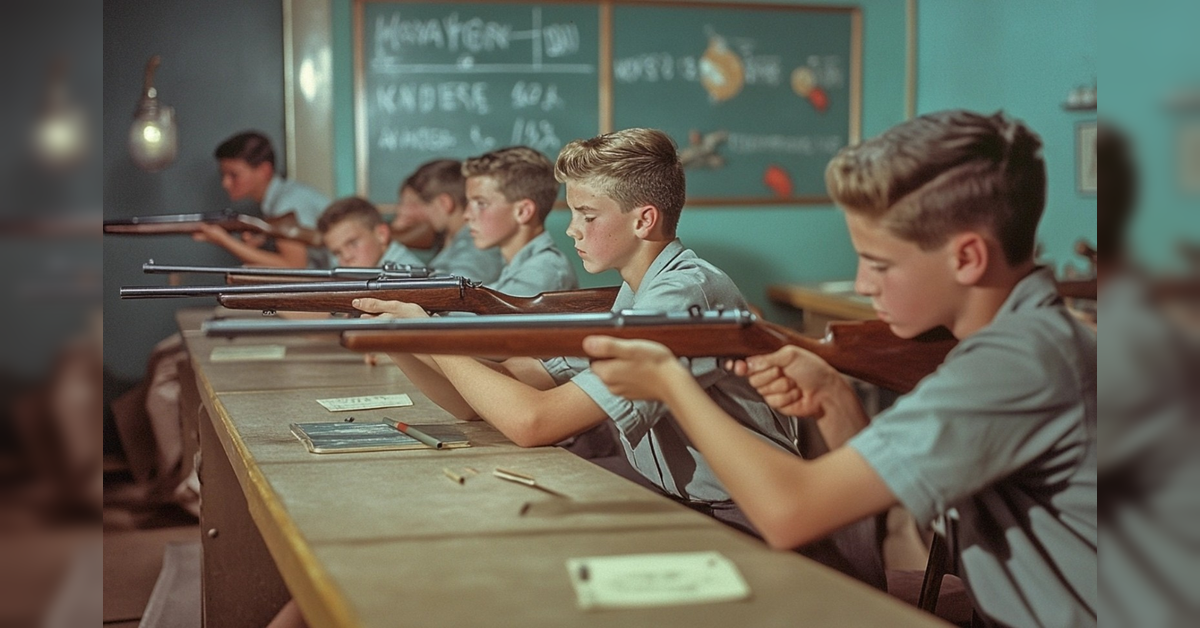Restoring An American Tradition For A Safer Future

LISTEN TO THIS ARTICLE
In a nation founded on the principles of liberty and the right to bear arms, with an estimated 400 million firearms in civilian hands, the question isn’t whether young Americans will encounter guns in their lifetime—but when. Despite this reality, comprehensive firearm safety education has largely disappeared from American schools, leaving millions of young citizens without proper knowledge about a constitutional right their forebears considered fundamental.
This educational gap not only increases safety risks but represents a failure to properly prepare the next generation of Americans to understand and exercise their Second Amendment rights responsibly.
This article explores why bringing firearm safety education back to schools represents not just a safety measure, but a reaffirmation of American values and traditions.
The Rich Historical Tradition of Firearm Education in American Schools
Firearm safety education in American schools isn’t a novel or radical concept—it’s a deeply rooted American tradition that has faded over time, primarily due to political pressures rather than educational merit. Throughout much of American history, firearms education was considered a normal and valuable part of growing up:
Early American Education and Firearms
From the colonial period through the early 20th century, familiarity with firearms was considered an essential life skill. Many schools, particularly in rural areas, incorporated some form of shooting sports or firearms education. The connection between education and firearms was so natural that even the first public school systems often included marksmanship as part of their curriculum.
The Golden Age of School Firearms Programs: 1910s-1970s
- From the 1940s through the 1970s, thousands of American high schools had shooting clubs and competitive rifle teams
- Many schools featured their own on-campus rifle ranges, particularly in the Northeast and Midwest
- The National Rifle Association’s youth education programs were standard in many physical education departments
- High school yearbooks from this era commonly feature photos of rifle teams alongside other sports teams
- Junior ROTC programs in schools frequently included marksmanship training
- 4-H clubs operating within the school system taught firearm safety as a core aspect of youth development
David Keene, former president of the National Rifle Association, noted in a 2018 speech: “As recently as the 1960s and early 1970s, students in New York City high schools carried their rifles on the subway to school for target practice. These young people were taught responsibility, discipline, and safety—values that served them well throughout their lives.”
Curriculum Integration
Firearm safety education wasn’t isolated to extracurricular activities. Many schools integrated aspects of firearms knowledge into their regular curriculum:
- Physical education classes often included marksmanship as part of developing overall coordination and discipline
- Science classes sometimes incorporated ballistics as practical applications of physics principles
- History courses naturally covered the role of civilian firearm ownership in American independence and western expansion
- Many rural schools had “outdoor education” components that included hunting ethics, conservation principles, and safe firearms handling

The Decline of Firearm Education
This educational approach began to decline in the late 1970s and accelerated through the 1990s. This decline coincided not with any evidence that such programs were ineffective or dangerous—indeed, the safety record of school shooting programs was exemplary—but rather with shifting political attitudes toward firearms and increasing urbanization.
By the early 2000s, most school districts had eliminated all firearms education, creating a knowledge vacuum that has contributed to misunderstandings and preventable accidents. Today, formal firearm education in schools is exceptionally rare, despite the continued presence and constitutional protection of firearms in American society.
Compelling Reasons Why Firearm Safety Should Be Taught in Schools
1. Accident Prevention Through Education: The Evidence
The most compelling argument for firearm safety education is accident prevention—a goal that transcends political differences. According to CDC data, unintentional firearm injuries remain a significant concern, particularly among young people who have not received proper education:
- States with hunter education requirements and widespread firearms safety training have consistently lower rates of accidental firearm injuries
- A 2018 study published in the Journal of Emergency Medicine found that children who receive formal firearm safety education are significantly less likely to handle firearms inappropriately if they encounter them
- Education focused on the proven safety rules—treating all guns as loaded, muzzle discipline, trigger discipline, and target awareness—creates a foundation for responsible behavior that lasts a lifetime
Jeff Cooper, renowned firearms instructor and creator of modern handgun techniques, stated: “Safety is something that happens between your ears, not something you hold in your hands.” This principle underscores why education is far more effective than ignoring the reality of firearms in our society.
Education effectively displaces curiosity—one of the primary factors in youth firearm accidents. When children understand the potential dangers of firearms and have been taught proper respect for them, they’re much less likely to handle guns improperly out of curiosity if they encounter one at a friend’s house or elsewhere.
2. Preserving Constitutional Knowledge and Heritage
The Second Amendment remains a cornerstone of American liberty, yet many young Americans receive little to no education about its history, purpose, or meaning. Firearm safety education provides an opportunity to teach not just practical skills but constitutional literacy:
- Students can learn about the historical context of the Second Amendment, including its role in securing American independence
- Education can cover Supreme Court decisions that have affirmed the individual right to keep and bear arms, such as DC v. Heller (2008) and McDonald v. Chicago (2010)
- Young citizens can develop an understanding of how the right to bear arms relates to concepts of individual liberty, self-governance, and personal responsibility
- This knowledge helps preserve America’s constitutional heritage regardless of whether students choose to exercise their Second Amendment rights as adults
As Supreme Court Justice Antonin Scalia wrote in the landmark Heller decision: “The very enumeration of the right takes out of the hands of government—even the Third Branch of Government—the power to decide on a case-by-case basis whether the right is really worth insisting upon.” Proper education ensures this constitutional principle remains understood by future generations.
3. Addressing the Reality of American Gun Ownership
With approximately 44% of American households containing at least one firearm according to Gallup (with some surveys suggesting even higher numbers), and with over 100 million American gun owners, the likelihood of a child encountering a firearm at some point is significant. Firearm safety education acknowledges this reality rather than pretending it doesn’t exist.
Furthermore, gun ownership continues to expand across demographic groups:
- Women represent the fastest-growing segment of new gun owners, increasing by an estimated 77% from 2005 to 2020
- Urban gun ownership has increased dramatically in recent years, particularly in response to civil unrest and reduced police funding
- First-time gun buyers surged during 2020-2022, with an estimated 8.4 million Americans purchasing their first firearm
As Alan Gottlieb, founder of the Second Amendment Foundation, observed: “We don’t ignore the existence of automobiles—we teach driver’s education. We don’t ignore the existence of swimming pools—we teach water safety. Why would we ignore the existence of firearms rather than teaching safety and responsibility?”

4. Building a Culture of Responsible Gun Ownership
Education creates a foundation for responsible gun ownership in future generations, strengthening rather than weakening Second Amendment rights. By teaching proper handling, storage, and the ethical responsibilities that come with firearm ownership, schools can help shape a culture that values safety, responsibility, and constitutional rights equally.
This approach recognizes that rights and responsibilities are inseparable concepts in a free society. As gun owners often note, the best defense against restrictions on Second Amendment rights is a culture of safe, responsible gun ownership that prevents accidents and misuse.
5. Removing Mystery, Fear, and Misinformation
Popular media and political discourse often portray firearms inaccurately, creating either exaggerated fear or dangerous misconceptions about how they function. Movies show improbable scenarios that may encourage unsafe behavior, while news coverage frequently demonstrates fundamental misunderstandings about firearms terminology and function.
Formal education can correct these misunderstandings and replace emotion-driven narratives with factual information:
- Students can learn the actual mechanics of how firearms work, dispelling myths about “automatic” weapons and “high-capacity clips” that dominate political discourse
- Education can distinguish between Hollywood depictions and reality, particularly regarding the effects and limitations of firearms
- Hands-on training (with appropriate safety measures) removes the mystery and allure that can make firearms dangerously fascinating to uninformed youth
- Understanding the proper context for firearms use—self-defense, hunting, sport shooting, and collection—helps develop appropriate attitudes toward firearms
Tom Gresham, host of the nationally syndicated radio program “Gun Talk,” notes: “Ignorance breeds fear, and fear breeds poor policy decisions. Education is the antidote to both.”
6. Creating Truly Informed Citizens on a Contentious Issue
Regardless of whether students choose to own firearms as adults, comprehensive education enables them to become informed participants in one of America’s most important ongoing policy debates. Without basic knowledge about firearms, citizens are vulnerable to emotional appeals, misinformation, and policies that may infringe upon constitutional rights without improving safety.
Education empowers future voters to evaluate claims about firearms based on facts rather than fear, strengthening democratic discourse and protecting constitutional rights.
7. Instilling Values That Transfer to Other Areas of Life
The core principles taught in firearms education—safety consciousness, personal responsibility, attention to detail, respect for potentially dangerous tools—transfer readily to other areas of life:
- The firearm safety principle of “always be sure of your target and what’s beyond it” teaches consideration of consequences beyond immediate actions
- Proper maintenance requirements teach responsibility and care for valuable property
- Range protocols teach discipline, focus, and following established safety procedures
- Shooting sports develop concentration, breath control, and fine motor skills
These transferable skills and values provide benefits even to students who never handle firearms outside of educational settings.
Models for Modern Firearm Education Programs
Modern firearm safety education can draw on several successful models that could be adapted for today’s schools while maintaining a strong pro-Second Amendment perspective:
Scalable Curricula Options
- The Eddie Eagle GunSafe Program, developed by the NRA, which has reached over 32 million children with age-appropriate safety messages
- The National Archery in the Schools Program (NASP), which has successfully integrated archery into physical education with an emphasis on safety and has reached over 18 million students
- Utah’s Hunter Education program, offered as an elective in many schools, which maintains an exceptional safety record while introducing students to responsible firearms use
- The Scholastic Shooting Sports Foundation programs, which operate in schools across the country teaching shotgun, rifle, and pistol disciplines
- The Civilian Marksmanship Program’s youth initiatives, which provide curriculum resources for schools interested in developing competitive shooting programs
Implementation Strategies
Schools could implement firearms education at various levels of involvement:
Basic Safety Education (Elementary School)
- Focus on the Eddie Eagle message: “Stop, Don’t Touch, Run Away, Tell an Adult”
- Introduction to the concept of the Second Amendment at an age-appropriate level
- Basic distinction between real firearms and toys
- Understanding that responsible adults may own firearms for legitimate purposes
Intermediate Education (Middle School)
- More detailed safety rules and the reasons behind them
- Basic mechanical understanding of how different types of firearms function
- Historical significance of firearms in American history
- Introduction to different legitimate uses of firearms (hunting, sport, self-defense)
Comprehensive Education (High School)
- Detailed Second Amendment education, including landmark court cases
- Hands-on safety training with appropriate supervision
- Introduction to shooting sports as physical education options
- Ethical dimensions of self-defense and firearms ownership
- Understanding of relevant laws regarding firearms ownership and carry
Success Stories: Where Firearms Education Works
Several states and school districts maintain successful firearms education programs that could serve as models:
North Dakota’s Hunter Education in Schools
North Dakota integrates hunter education directly into school curricula, typically in physical education or agriculture classes. The program reaches thousands of students annually and contributes to North Dakota having one of the lowest rates of firearms accidents nationwide.
Georgia’s State Championship Shooting Programs
Georgia schools participate in state championship events for shotgun sports through the Georgia High School Association, treating shooting sports with the same legitimacy as traditional athletics. The program has grown rapidly and maintains a perfect safety record.
Pennsylvania’s National Archery in the Schools Program
While focusing primarily on archery, this program demonstrates how schools can successfully integrate shooting sports into standard curricula. The discipline and safety consciousness developed through archery creates a foundation for responsible firearms handling.
Texas 4-H Shooting Sports in Schools
Many Texas schools partner with 4-H to offer shooting sports education, reaching over 15,000 youth annually with comprehensive firearms safety training that emphasizes responsibility and heritage.
Addressing Common Concerns from a Pro-Gun Perspective
Critics of firearm education in schools often express concerns that must be addressed to implement successful programs:
“Firearms don’t belong in schools”
Education does not necessarily require actual firearms in all settings. Programs can utilize inert training devices, simulators, and other teaching tools while reserving live-fire experiences for appropriate off-campus facilities. The focus is on education, not necessarily having firearms physically present in classrooms.
“Parents should teach firearms safety, not schools”
While parental instruction is valuable, not all parents possess the knowledge or experience to provide proper firearms education. Schools have traditionally supplemented home instruction in many areas of life. Additionally, standardized education ensures all children receive consistent safety information, not just those from firearms-owning households.
“Such programs might promote gun violence”
This concern contradicts all available evidence. Areas with the highest rates of formal firearms education typically have the lowest rates of firearms misuse and accidents. Education and respect for firearms correlates strongly with responsible, lawful use.
“Programs might clash with family values”
This concern can be addressed through:
- Transparent curriculum development with community input
- Parental notification of program content
- Opt-out provisions for families who object
- Focus on safety and constitutional education rather than promoting one view of gun ownership

The Path Forward: Restoring America’s Tradition of Firearms Education
Restoring firearms education to American schools requires determined advocacy from parents, educators, and Second Amendment supporters. The following steps can help achieve this goal:
Local School Board Engagement
Local school boards have significant authority over curriculum decisions. Organized groups of parents and community members can advocate for age-appropriate firearms safety and education programs at board meetings and through direct engagement with board members.
State-Level Legislation
Several states have considered or passed legislation encouraging or requiring firearms safety education in schools. Supporting such legislation and working with state representatives can create frameworks for implementing programs.
Public-Private Partnerships
Organizations like the NRA, National Shooting Sports Foundation, and firearms manufacturers offer educational resources, funding, and expertise that can supplement school programs. These partnerships can reduce implementation costs while ensuring high-quality content.
Teacher Training and Certification
Developing specialized training for educators who will lead firearms education programs ensures quality instruction and safety. Organizations like the NRA offer instructor certification programs specifically designed for teaching youth.
Curriculum Development
Creating comprehensive, age-appropriate curricula that align with state educational standards helps integrate firearms education into existing school frameworks rather than treating it as an add-on or extra program.
Conclusion
Firearm safety education in schools represents not just a pragmatic approach to preventing accidents but a reaffirmation of American constitutional values and traditions. By teaching respect for firearms, proper handling procedures, and the serious responsibilities that come with Second Amendment rights, schools can help create a safer environment while preserving America’s heritage of responsible firearm ownership.
In an era when political attacks on gun rights continue unabated, education represents a proactive approach that acknowledges the continued importance of firearms in American life while promoting the knowledge and skills needed for their safe and responsible use. By reviving this once-common educational tradition, we can better prepare young Americans to become the informed, responsible citizens and gun owners our founders envisioned.
The path forward requires courage and determination from Second Amendment advocates, parents, and educators who understand that firearms education represents not a dangerous innovation but a return to proven educational practices that served American youth well for generations. The time has come to restore this vital component of American education and ensure that our constitutional rights are preserved through knowledge, responsibility, and practice.
Read the full article here









